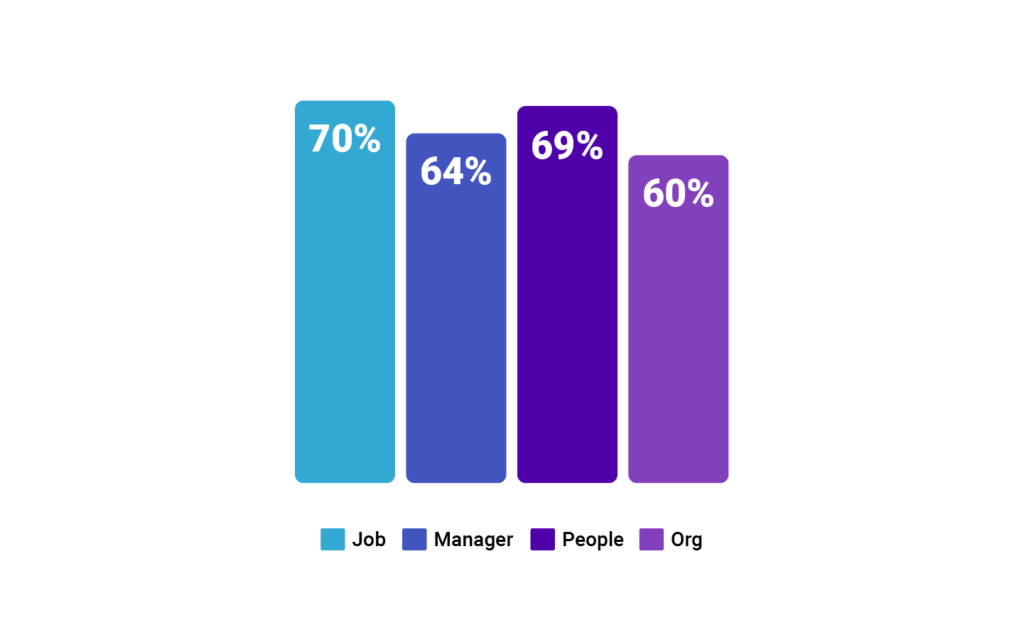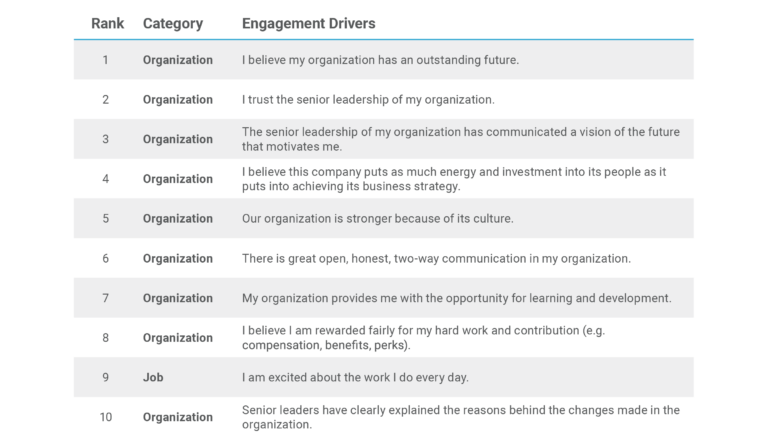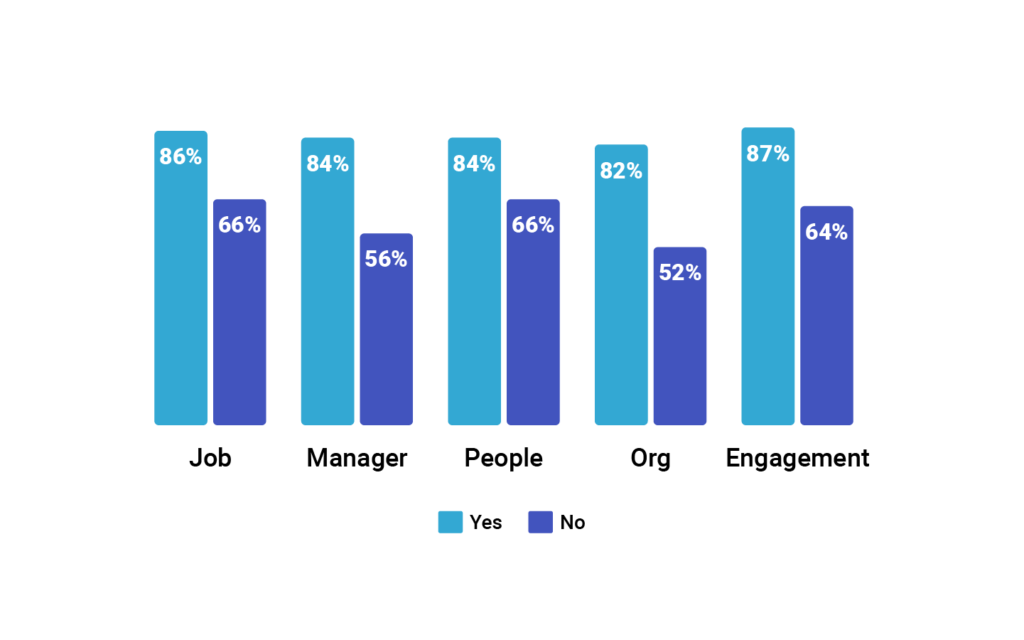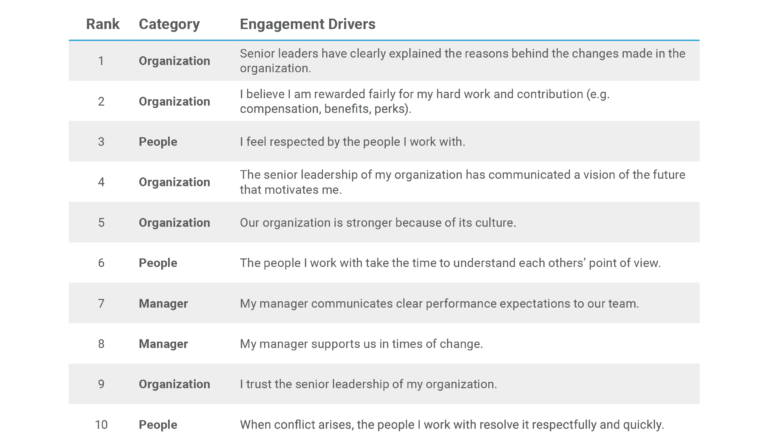
Employee Engagement Report
Study reveals why people really quit—and what makes them go the extra mile
Introduction
In February of 2019, The Predictive Index® surveyed 3,000 employees across 20 industries to understand which factors had the greatest impact on employee engagement and turnover. Their answers paint a picture of the current state of engagement in the U.S. They also unveil how companies can get the most out of their people and retain top talent.
When employees are engaged, companies win financially. One Best Buy store quantified the annual value a 0.1% increase in engagement: $100,000. On the other hand, disengaged employees drain the coffers: companies with engaged workers grew their earnings per share 27.8% over 12 months, while low engagement companies experienced an 11.2% decline in earnings per share over the same period, according to Towers Perrin.
Findings are broken down into five sections:
Section 1
What makes workers go the extra mile
The state of employee engagement in 2019
In the U.S., the composite engagement rate is 71%.
To begin, the study offers a birds-eye view of overall employee engagement. The panel of 3,000 workers rated the following four engagement items on a scale of 1 (strongly disagree) to 5 (strongly agree).
- I am proud to say I work for this organization.
- I would recommend my organization to others as a great place to work.
- Overall, I am very happy to be working at my organization.
- It would take a lot to get me to leave my organization.
The results depict a more engaged workforce than some accounts would have you believe—but there’s still much room for improvement.

Engagement across categories
On the whole, people feel more satisfied with their jobs and their co-workers and less satisfied with their managers and their organizations.
With overall engagement measured at 71%, the study dove a bit deeper. The panel of 3,000 workers rated a list of 54 items spanning four categories:
- Job
- Manager
- People
- Organization
Respondents rated each item on a scale of 1 (strongly disagree) to 5 (strongly agree). About 70% of respondents enjoy their job, 69% like their co-workers, 64% feel favorably about their direct manager, and 60% are happy with their company.

Top 10 drivers of engagement
Nine of the top 10 engagement drivers involve the company and its senior leaders (i.e., organization).
Next, the study aimed to uncover the top 10 influencers of employee engagement: Which list items are deemed most important? What makes people go the extra mile? To determine this, researchers ran a correlation analysis against the list of 54 items and the four engagement items.
The results show that organizations—and the decisions executives make—have the biggest impact on engagement.

Section 2
What causes people to quit
Top 10 drivers of turnover intention
Nine of the top 10 drivers of turnover pertain to the organization—people leave bad companies.
Next the study sought to get to the root of what makes people want to quit their jobs. Was having a bad manager the primary culprit? Was it holding a job that’s a bad behavioral fit? To determine turnover intent (i.e., whether respondents had begun to consider working at a different company), researchers examined how they rated the following engagement item:
“It would take a lot to get me to leave my organization.”
Researchers then did another correlation analysis to identify the top 10 drivers of turnover intent—or what causes people to quit. As was the case with engagement, turnover intention is more about the company and its executive team than anything else.
As the data shows, whether people choose to stick around or leave depends on their faith in the company’s future, its C-Suite, and its people investment.

Section 3
Other factors that determine engagement
Organization size and engagement
While there’s no definitive connection between engagement and company size, employees at small companies feel more favorably about their jobs.
Does the size of an organization make a difference in how engaged its employees are?
Overall engagement numbers showed no clear upward or downward trend. None of the four categories showed a linear climb or drop based on company size either. That said, the job category saw the widest spread in engagement rates when comparing the smallest organization (74%) to the largest organization (64%).

Organization age and engagement
As your company ages, pay extra attention to pulling the levers that increase engagement; career pathing can help increase job satisfaction.

Is there a correlation between engagement levels and the age of a company?
Overall engagement dipped steadily as company age increased (77% at companies five years old or younger to 68% at companies more than 30 years old). Additionally, engagement with one’s job also decreased along with the company’s age (77% at companies five years old or younger to 67% at companies more than 30 years old).
Section 4
Assessments and engagement
Organization age and hiring assessments and engagement
If you use behavioral assessments to hire the right people, you’re likely to see better engagement scores.
The study also explored the relationship between behavioral assessments and employee engagement. To that end, respondents were asked whether they were assessed as part of the hiring process.
The data shows that average engagement across those who work at companies that use assessments in the hiring process is 84%. Of the respondents who said their organization does not use assessments to hire, engagement levels were only 62%.

Assessment results and engagement
Employees who are aware of their assessment results report 87% engagement; employees who aren’t aware report 64% engagement.

Employees who took behavioral assessments as part of the hiring process were asked whether they were given their results. Engagement levels of those who said yes and those who said no were compared.
The data shows that giving employees access to their assessment results can boost engagement. Overall engagement scores are higher among the group of people who are aware of their assessment results. In a similar fashion, engagement scores across each of the four categories—job, manager, people, and organization—were also higher among those made aware of their assessment results.
Workforce assessments have multiple use cases—from ensuring job fit to building self-awareness. Either of these use cases could be the cause of increased engagement.
Assessment results and assessments for team building and engagement
Companies that use assessments to improve team communication and collaboration see higher engagement rates than companies that don’t.
To examine the link between engagement and using behavioral assessments for team building, the panel was asked if their company uses assessments to improve teamwork.
Across the board, engagement is significantly higher among the people who work for companies that do use assessments as a means of improving team communication and collaboration.

Cognitive assessments and engagement
Companies that use cognitive assessments as part of the hiring process see higher engagement than companies that don’t.

Finally, the study examined the relationship between cognitive assessments and employee engagement. Respondents were asked whether their organization uses cognitive assessments as part of the hiring process.
There’s a noticeable correlation between the use of workplace cognitive assessments and greater engagement rates. Companies that did use cognitive assessments in hiring saw engagement levels of 86%. Companies that didn’t use cognitive assessments in hiring saw engagement levels of 64%.
Section 5
Industry stats
Top drivers of engagement in hospitality and food service
Ensure a highly engaged workforce by hiring the right behavioral fit; they’ll likely be excited to come to work every day.
One might expect to see a diversity of engagement drivers depending on the industry. However, the No. 1 driver of engagement pertained to the organization category in all but two of the 20 industries. The hospitality and food services industry was one of those two.
As you can see, the No. 1 engagement driver in hospitality and food services pertains to the job category: “I am excited about the work I do every day.” The remaining nine engagement drivers pertain to the organization and the people in it.

Top drivers of engagement in construction
If you’re a people manager in the construction industry, your actions have a major impact on the effort your employees put in; work hard and show integrity.
As mentioned, the No. 1 driver of engagement pertained to the organization in all but two industries. The construction industry was the second of the two.
For employees in the construction industry, having a great manager leads to higher engagement: “My manager works and manages with integrity.” As the data shows, the remaining top engagement drivers are split between manager and organization—with manager items composing 40% of the top 10.

Top drivers of turnover in hospitality and food service
To reduce turnover, ensure alignment between employee behavioral drives and job duties; and ensure jobs make excellent use of employees’ skills.

One might also expect to see diversity of turnover drivers depending on industry. However—like engagement—the No. 1 driver of turnover pertained to the organization in all but two of the cases. Hospitality and food services was one of the two.
As you can see, the No. 1 turnover driver in hospitality and food services pertains to the job category: “I am excited about the work I do every day.” (This is the same No. 1 engagement driver in this industry.) The remaining nine engagement drivers cover the organization, people, and manager categories.
Top drivers of turnover in transportation
In the transportation industry, factors that influence workers’ desire to quit are misalignment with the company, misalignment with their job, and misalignment with their co-workers.
Another unique industry-specific finding is that transportation employees make the decision to quit based on job fit. One-third of the turnover intention items pertain to the job category.
If people don’t feel excited about the work they do on a daily basis they’re likely to leave, so business leaders should take care to foster that excitement and find opportunities to make great use of individuals’ skills and abilities.
Also, employees in the transportation industry quit because of their co-workers. In fact, another third of the top turnover drivers relate to the people category.
Leaders in the transportation industry can reduce turnover by giving employees the tools and training to help them understand each other better.

Survey methodology
In February of 2019, The Predictive Index conducted a survey of executives, managers, and individual contributors across diverse industries. We secured respondents through market research firm Critical Mix (now part of Dynata).
PI started with a pool of 94 Likert scale items, asked on a 5-point strongly disagree to strongly agree scale. All questions were required, and a not applicable option was provided as an “out.” In an attempt to avoid survey fatigue, two versions of the survey were created—each contained about 65 items. Responses were collected over the course of two weeks in February 2019.
The following psychometric analyses were run:
- Basic score calculation. PI assessed the mean, % favorable, % neutral, and % unfavorable of each item. Items that scored extremely high, or that had a large amount of neutral scores, were flagged as potential removals.
- Factor analysis. PI assessed the way the items naturally wanted to group together so we could ensure the way we presented the items in categories accurately captured the experiences survey takers were considering when thinking about their day-to-day work.
- Reliability analysis. Confirming the factor analysis, PI ensured that the items grouped together in each category were related but not overlapping. The objective was to cover as many aspects of each category as possible without redundancy.
- Correlations. Which items correlate most highly with engagement? As one of the intents of asking items beyond engagement was to provide items upon which leaders and managers can take action to influence engagement, PI ensured that all survey items had a linear relationship with engagement.
Following those analyses, the final survey was created, consisting of 10 Job items, 10 Manager items, 10 Team items, 16 Organization items, and 4 Engagement items.
Through those means, we collected 3,010 completed survey responses. Here’s some information about the respondent pool:

Employee level:
- Executives – 5% of the population
- Manager/Supervisor – 20% of the population
- Individual Contributor – 75% of the population
